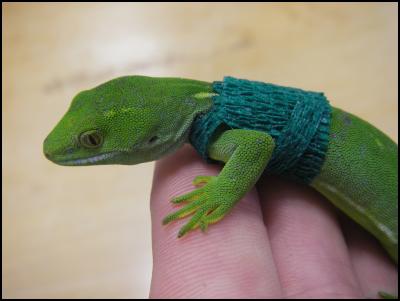Matiu/Somes Island a resort for ‘lounge lizards’
4 May 2007
Matiu/Somes Island a resort for
‘lounge lizards’

Reptiles being rescued from the perils of city life to enjoy the tranquillity of Matiu/Somes Island are to be outfitted in the style of lounge lizards sporting “ipods”.
Green geckos rescued from the clutches of urban cats or raised in captivity, will be fitted out with tiny green “lounging” jackets before starting a new life on the Department of Conservation-managed sanctuary in Wellington Harbour later this year. It’s not about protecting them from Wellington’s notorious winds, or creating a reptilian fashion statement.
The polyester/latex harnesses, which resemble pet jackets, are an ingenious means of fitting two of the geckos with transmitters so their progress can be monitored. The movements of the pair will be monitored daily by DOC staff and volunteers for 10 days after their release this month, to find out where they go. It will pave the way for a larger study in 2008.
Thirty green geckos will be relocated from the city to the island over the next two years, with the first transfer of six planned for Sunday. The jacket-clad geckos will join them in spring.
Also travelling to the island this weekend are two forest geckos and 12 ornate skinks, handed into DOC by people who have rescued them from cats and building sites.
“More people are rescuing native skinks and geckos as they become more aware of the presence of these native animals in our city,” DOC biodiversity ranger Andrew Morrison said.
DOC welcomes this support from the public to boost the reptilian population on Matiu/Somes Island, he said. It is already an important refuge for lizards in the Wellington region with four skink species, two gecko species and Brothers Island tuatara all present. By transferring Wellington green geckos there it is hoped that a self sustaining population will become established away from the threats of introduced predators and habitat destruction.
“At this stage we are really only interested in ornate skinks and forest and green geckos for the island. But we would like to think that other species are also being rescued,” Mr Morrison said.
Lizards rescued from cats should be kept in a box or darkened cage to recover overnight before being released back into the garden. Rocks, tiles, bricks can be used to provide them with a safe refuge.
Both forest and green
geckos are declining nationally due to habitat loss and
predation by introduced species. Forest geckos can be
recognised by the range of bark-like patterns in grey, brown
and sometimes green for camouflage on their skin. The inside
of the mouth and tongue is bright yellow to orange. Green
geckos have bright green skin often marked by two rows of
yellow cream to white blotches, and the inside of their
mouth is blue.
Geckos have baggy, velvety skin and broad
heads while skinks have shiny, tight-fitting skins and look
like snakes with legs. They both eat insects and fruit.
Find out more about lizards on the DOC website:
www.doc.govt.nz/lizards ENDS
Cat owners can help protect native wildlife by .-
- Having their cat neutered or spayed so they can't produce unwanted kittens. Responsible cat ownership means not breeding unwanted litters - cats should be neutered or spayed unless they want to raise kittens.
- Keeping their cat well fed and providing moving toys for it to play with, so it is less inclined to chase native wildlife.
- Keeping their cat indoors overnight so nocturnal insects and lizards have free reign of the garden.
- Not dumping unwanted kittens and cats - either give them to the SPCA or ask a vet to put them down humanely.
- Considering not keeping a cat if they live near an area known for its wildlife.
Greater Wellington Regional Council is highlighting the danger that cats pose to native wildlife in its Be the Difference campaign. Find out more on the council’s Be the Difference website: www.bethedifference.gw.govt.nz
ENDS


 Bill Bennett: Download Weekly - 100% claim lands One New Zealand in criminal court action
Bill Bennett: Download Weekly - 100% claim lands One New Zealand in criminal court action FSCL: Woman Scammed Out Of $25,000 After Job Offer On LinkedIn
FSCL: Woman Scammed Out Of $25,000 After Job Offer On LinkedIn NIWA: Cheers To Crustaceans - New Species Named After Welly Brewery
NIWA: Cheers To Crustaceans - New Species Named After Welly Brewery MBIE: Trans-Tasman Earth Observation Research Studies Confirmed
MBIE: Trans-Tasman Earth Observation Research Studies Confirmed NZ Association of Scientists: Royal Society Te Apārangi Governance Submissions Close - NZAS Submission
NZ Association of Scientists: Royal Society Te Apārangi Governance Submissions Close - NZAS Submission HortPlus: Project Aims To Improve Quality Of Weather Data In New Zealand
HortPlus: Project Aims To Improve Quality Of Weather Data In New Zealand



